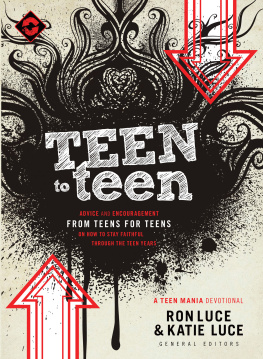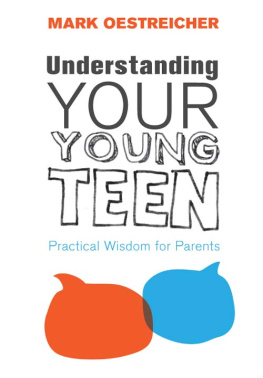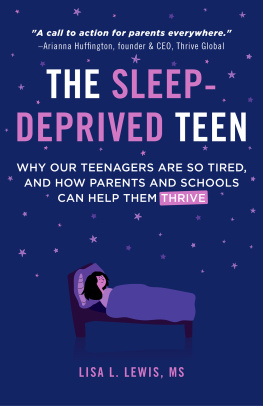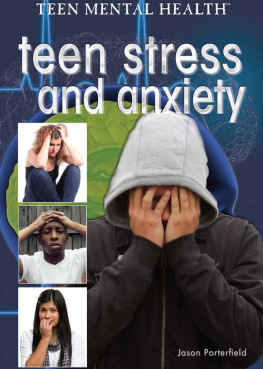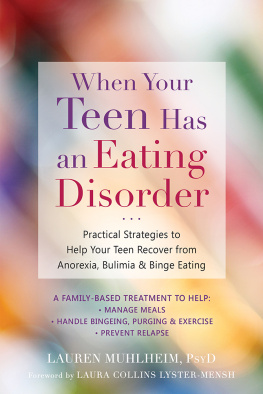THE AMERICAN ACADEMY OF CHILD AND ADOLESCENT PSYCHIATRY
YOUR ADOLESCENT
Emotional, Behavioral, and
Cognitive Development from
Early Adolescence through the Teen Years
David B. Pruitt, M.D., Editor-in-Chief

E DITOR-IN -C HIEF
David B. Pruitt, M.D.
Professor of Psychiatry and Pediatrics
Director, Division of Child and Adolescent Psychiatry
University of Maryland School of Medicine
Baltimore, Maryland
A SSOCIATE E DITORS
Claudia Berenson, M.D.
Associate Professor, Psychiatry and Pediatrics
University of New Mexico
Albuquerque, New Mexico
William Bernet, M.D.
Associate Professor, Department of Psychiatry
Vanderbilt University School of Medicine
Director
Vanderbilt Forensic Psychiatry
Nashville, Tennessee
Jerry Heston, M.D.
Associate Professor of Psychiatry
Division of Child and Adolescent Psychiatry
University of Tennessee, Memphis
Medical Director, Behavior Health Unit, Le Bonheur Childrens Medical Center
Memphis, Tennessee
Paramjit T. Joshi, M.D.
Chief, Division of Behavioral Medicine and Chair, Department of Psychiatry and Behavioral Sciences
Professor of Psychiatry & Pediatrics
Childrens National Medical Center
George Washington University School of Medicine
Washington, D.C.
Penelope Krener Knapp, M.D.
Professor, Psychiatry and Pediatrics
University of California, Davis
Davis, California
James C. MacIntyre II, M.D.
Associate Professor of Psychiatry
Albany Medical College
Albany, New York
D EPUTY E DITORS
Paul L. Adams, M.D.
Louisville, Kentucky
Virginia Q. Anthony
Washington, D.C.
C ONTRIBUTING E DITORS
Thomas Anders, M.D.
Davis, California
Alan Axelson, M.D.
Pittsburgh, Pennsylvania
Larry Brown, M.D.
Providence, Rhode Island
Catherine DeAngelis, M.D.
Baltimore, Maryland
David Fassler, M.D.
Burlington, Vermont
Henry Gault, M.D.
Northbrook, Illinois
Gerald Golden, M.D.
Philadelphia, Pennsylvania
David Herzog, M.D.
Boston, Massachusetts
Steven Jaffe, M.D.
Atlanta, Georgia
Allan Josephson, M.D.
Augusta, Georgia
Henrietta Leonard, M.D.
Providence, Rhode Island
Alexander Lucas, M.D.
Rochester, Minnesota
Bruce D. Miller, M.D.
Buffalo, New York
Frederick Palmer, M.D.
Memphis, Tennessee
Rachel Z. Ritvo, M.D.
Rockville, Maryland
John Schowalter, M.D.
New Haven, Connecticut
Robert Schreter, M.D.
Lutherville, Maryland
Larry Silver, M.D.
Washington, D.C.
Michael Silver, M.D.
Wynnewood, Pennsylvania
Deborah Simkin, M.D.
Fort Walton Beach, Florida
E DITORIAL D IRECTOR
Hugh G. Howard
Red Rock Publishing, Inc.
East Chatham, New York
C ONTRIBUTORS
Dale Gelfand
Spencertown, New York
Elizabeth Lawrence
East Chatham, New York
Dawn Micklethwaite Peterson
Maplewood, New Jersey
Elizabeth Tinsley
Chatham, New York
Lyn Yonack
Great Barrington, Massachusetts
Child and adolescent psychiatry begins with a profound respect for your adolescent, his or her endowments, and a deep regard for the task of parenting.
For more than two decades, I have attended seminars, case conferences, grand rounds, scientific meetings, and committee meetings. Both as a parent and in my professional capacity, I am invariably struck that this respect pervades virtually every presentation about individual youngsters by child and adolescent psychiatrists. Discussions, publications, and stories share this appreciation for the adolescent, and the individuals strengths and uniqueness. And so, you will find, does Your Adolescent .
The Academy was founded in 1953 by eighty-one child and adolescent psychiatrists who saw a need for a forum to focus on the clinical, educational, and research problems unique to children. The early meetings were informative. The struggles for separation from other medical and mental health groups, for new ties, and for a sense of identity were earnest and absorbing. Differences in values and focus from other professions led to the founding of the Academy as an academic association, but over more than four decades of growth, the agenda here at the Academy has developed to include vigorous advocacy for children and adolescents, an outstanding program of professional education, and an increasing focus on prevention and public health.
In the past fifteen years, the Academy has reached out to you as parents and members of extended families. We recognize that you are on the front line, whether your role is as a parent, grandparent, or caregiver. You deal daily with disorders of adolescence and other parenting issues and concerns. Since early identification is one of the most effective forms of prevention, we believe our outreach can help in preventing or limiting the pain, trauma, and failure experienced by children and adolescentsand perhaps reduce the anguish and heartache felt by parents of youngsters in distress.
Our attempts to inform the public are not aimed solely at the parents of the children and adolescents who need professional help. Often, in part because of todays very stressful homework environment, parents need reassurance about the differences between personality and temperament, and education about what constitutes the normal phases of growing up. We can provide guidance about when you should be concerned about your adolescent and, ultimately, whether you should seek treatment.
Over a career, a child and adolescent psychiatrist learns a great deal from and about families, about specific resilience and breaking points, about vulnerabilities and elasticities, and about how teens with the same parents can be so alike and yet so different. This book is an outgrowth of a vigorous parent education effort based on that learning. This volume addresses normal development, normal problems, as well as more serious disorders and concerns with adolescents. It is a way of sharing child and adolescent psychiatrys appreciation of the teenage years, developmental milestones, and adolescent achievement with you, the parents, grandparents, and caregivers, who are caring and concerned, anxious, or just inquisitive.
The Academy is very proud of Your Adolescent as a key part of our ongoing partnership with parents. We commend David B. Pruitt, M.D., Hugh Howard, the editorial board, and the many authors, readers, and critics who have contributed to this offering.
Virginia Q. Anthony, Executive Director
A parent helps her fifteen-year-old son pack for a summer program at a college some 200 miles away. When she pushes aside a pile of underwear to squeeze in some clean socks, the mother notices that in the bottom of the suitcase, along with the shaving equipment he thinks he needs, her son has stowed a family picture and a small stuffed animal. She muses that even though he has a girlfriend, will soon have a drivers license, and can be as exasperating and opinionated as any adult she has ever met, within his grown-up-size body, underneath the deep voice and behind the often-defiant eyes, is a tender, tentative, uncertain child.
Every parent forgets, at moments, that there is a child still lurking within their adolescent. That forgetfulness is particularly likely when you are in the grips of the power struggles that all too often characterize the parent-child relationship during the teenage years. By the time your child has reached adolescence, chances are that you have succeeded in providing him (or her) with a firm sense of roots, a sense of belonging, of love and attachment. You may have afforded him ample opportunity to develop and test his wings, too, to gradually and increasingly experience himself as a separate, independent being.


